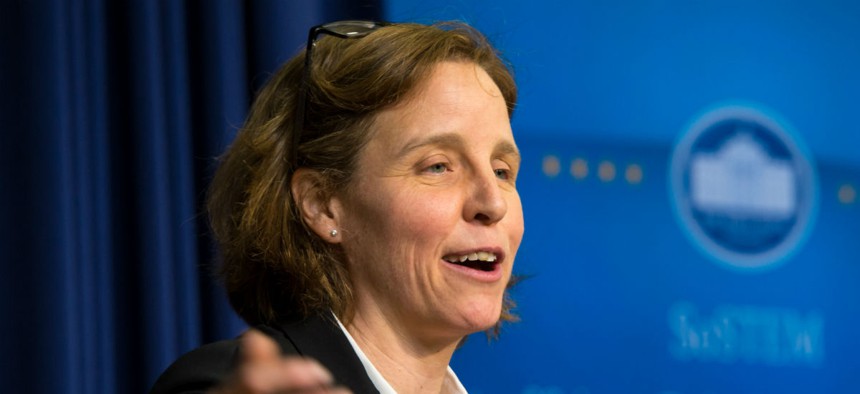
U.S. Chief Technology Officer Megan Smith said agency teams are “laying the foundation of the next wave of the data movement.” Bill Ingalls/NASA file photo
Obama White House Makes Big Final Push for Enduring IT Reforms
Officials cheer on agency and industry innovation at Open Data Summit.
With only weeks to go in its bid to create a tech-savvy 21st century government, the Obama White House on Wednesday rolled out a retrospective of its digital efforts at government transparency.
On the same day, the Obama administration’s top tech officials gathered with more than 1,100 agency staff and industry entrepreneurs at the Open Data Innovation Summit and Solutions Showcase at the Washington Convention Center.
“Since 2009, the administration has made significant progress opening up data sets that have never before been public, and creating new pathways to civic engagement,” the retrospective stated. A fact sheet. Officials shared a timeline of directives and itemized digital achievements ranging from tools for selecting a college to making police data readily available to simplified government spending websites such as data.gov.
“President Obama has personally helped lead us and made sure each of us involved is really committed to open government,” U.S. Chief Information Officer Tony Scott told summit attendees. The goal was and continues to be creating “a climate and ecosystem that leverages technology to transform the way government works,” Scott added, noting that the crowd was much larger than at similar events a decade ago.
Despite spending $80 billion a year on information technology, the government still has too many legacy systems that need modernizing, he noted. But the 200,000 data sets that agencies have created “are going to blossom into many more.”
Scott added: “It is important to pass on these principles to the next administration. This is a moment in time, a huge opportunity so that in 10-15 years we will look back and say, ‘This was the time when things started to change.’ ”
Megan Smith, the U.S. Chief Technology Officer, greeted the agency teams present that she said were “laying the foundation of the next wave of the data movement.” They included staff from the General Services Administration, the Census Bureau, the Environmental Protection Agency, the Agriculture Department and NASA.
She also called forth the “roots” of the data movement going back to George Washington, “a surveyor and engineer who founded the U.S. Army Corps of Engineers to do early design of the water we drink.” Inventor-statesman Benjamin Franklin and surveyor-farmer Benjamin Banneker, she said, collected data that anticipated today’s agriculture extension programs. And Navy leaders “at the time of Darwin got sailors to record weather, wind and conditions” that were the forerunners of today’s National Geospatial Intelligence Agency and U.S. Geological Survey, “crowd-sourcing” that in the 19thcentury shortened sailing time from New York to San Francisco from a year to three months, Smith said.
She singled out the Commerce Department for using datasets to measure the gender pay gap, and the Health and Human Services Department for using data to improve the foster care system.
Further “storytelling” and solutions showcasing during the conference came from private company entrepreneurs and stressed the untapped potential for improving government through crowd-sourced data demonstrations and standardization.
The five House members who spoke -- Reps. Mike Quigley, D-Ill.; Sean Moulton, D-Mass.; Mark Meadows, R-N.C.; Blake Farenthold, R-Texas; and Will Hurd, R-Texas -- all agreed that IT is the capital’s one truly bipartisan issue.







